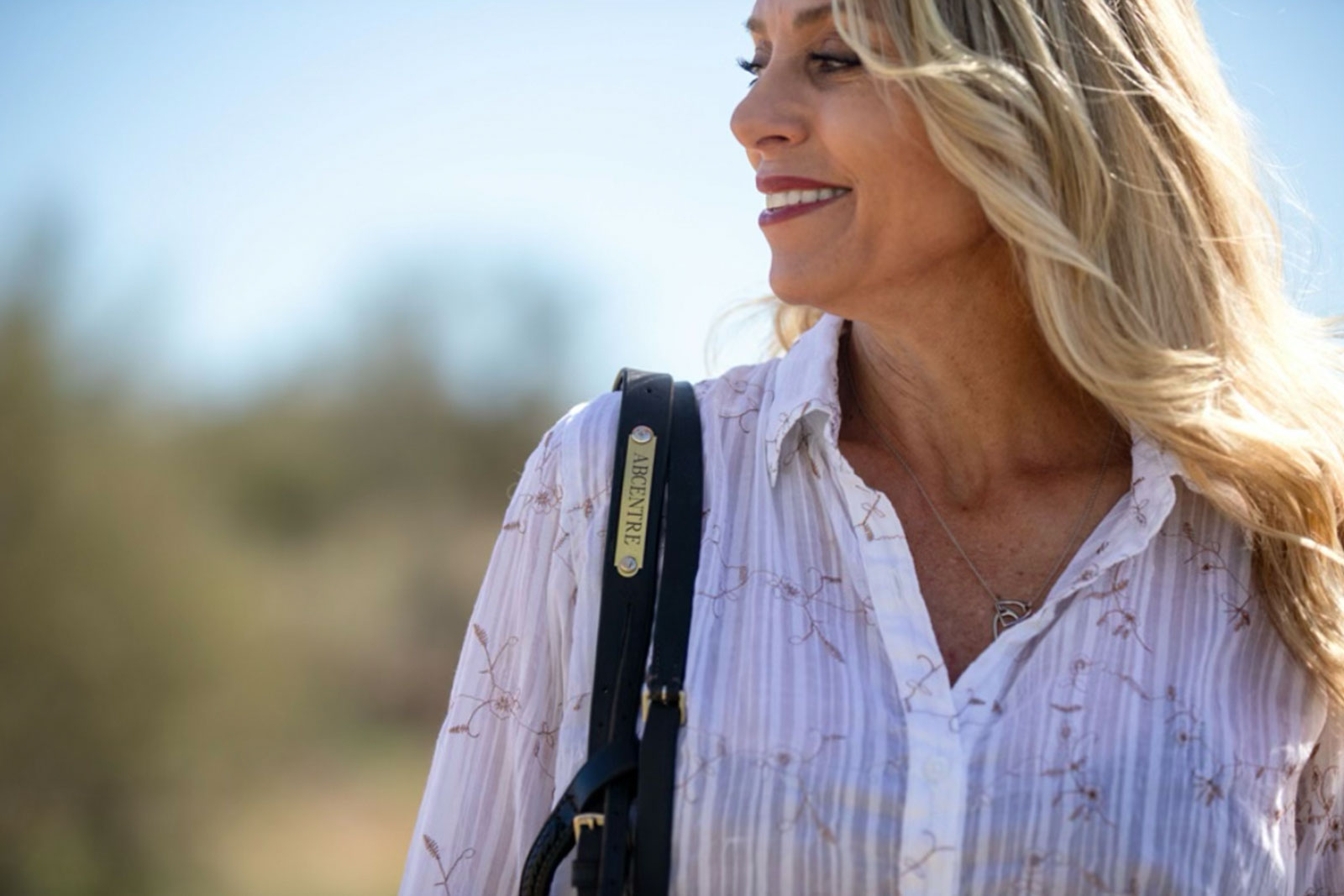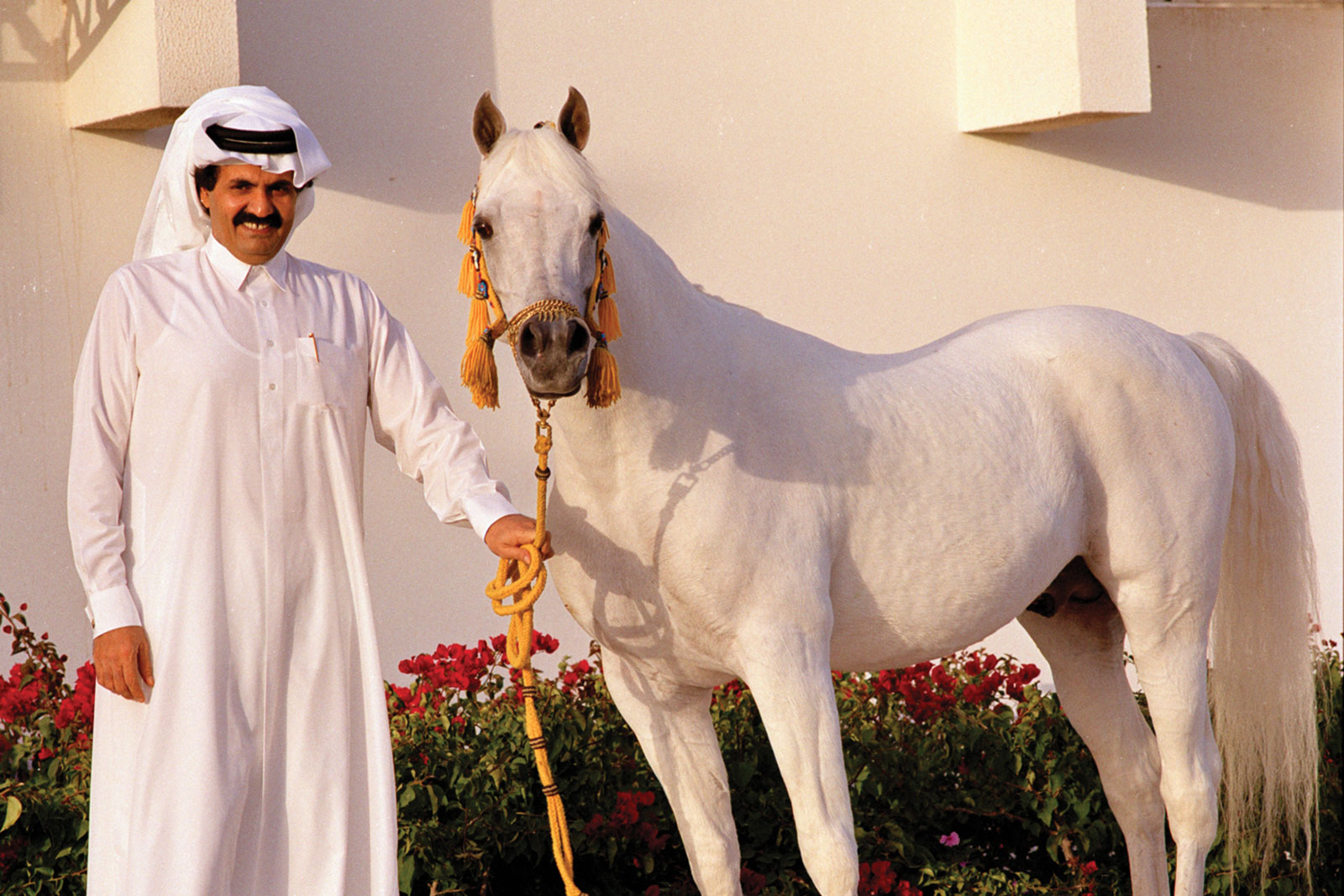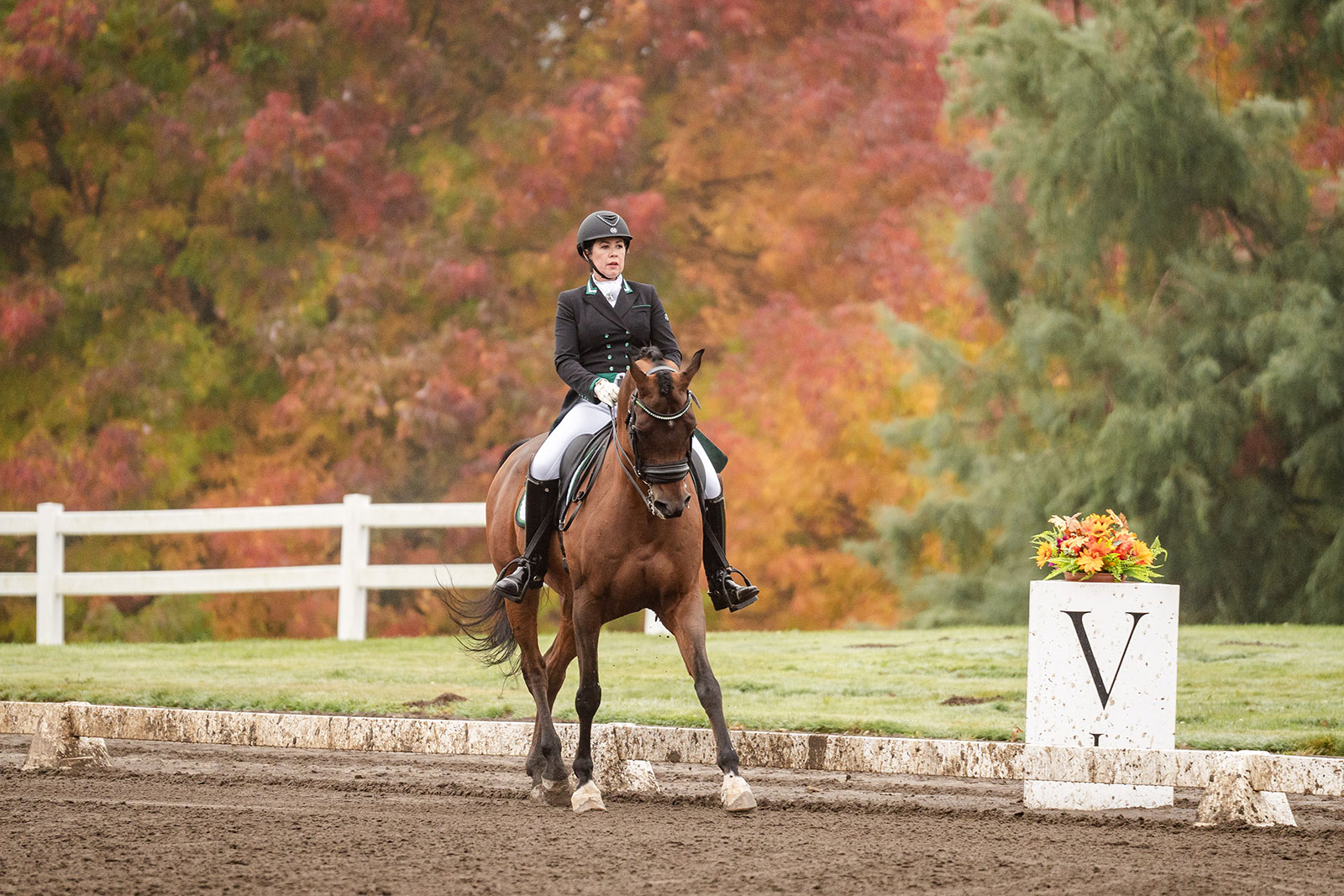By Jim Robbins
A farm and family with both a legacy and a purpose is how I’d best describe the Bilbreys and their Doubling Gap Ranch outside Newville, PA. Descending from generations of farmers in Kansas, Teresa Bilbrey met John Paul (JP) at Kansas State University, and they’ve been a team ever since. Through JP’s travels with work and family relocations that went with that, the Bilbreys have lived literally around the country and the world, exposing their children to diverse cultures and opportunities that have helped shape them into the strong, focused family they are today. They spent several years in the Middle East with some of their fondest memories as a family living in Cairo in an apartment above the stables, with Teresa riding almost daily and the family joining on the weekends with a view of the Great Pyramids from their veranda. Today, their son Grant, his wife Carri, and their three children Sarah, Camille, and JP (named after John) have built a life in the country surrounded by the animals they have grown to appreciate and love so deeply.
The Doubling Gap Ranch is roughly midway between Philadelphia and Pittsburgh in historic Cumberland County. JP acquired the 300-acre ranch in 2014 when he was involved with the Hershey Company as their CEO, and the location worked for the family. Over the last decade, with the help of their event manager Cindy “CJ” Jewart, JP, Teresa, Grant, Carri, and their children have all helped to make Doubling Gap Ranch an important part of their community, equestrian and social. They’ve hosted everything from riding clinics with some of the top trainers in the country (in all disciplines) to youth shows to dog trials and goat showmanship clinics. The facility is state of the art, with 27 stalls, beautiful pastures and fencing, individual paddocks, and all the amenities one would expect from a first-class operation. Not limited to Arabians, the farm started with blue and red roan working Quarter horses of Valentine and Hancock breeding. JP could have been a geneticist in a different life, with his interest and knowledge of genetics, and he brings these qualities to the table with his equine and cattle operations. His goals with the Quarter Horses were to breed and train structurally correct, sound-minded quality horses that any owner would be proud to have as their own. His purebred Hereford cattle operation is run in the same manner, with Grant at the helm, and they usually have around a dozen calves each year. The Arabians are both a love story and a passion for JP and Grant, and it all started due to a tragic barn fire in Delaware……..
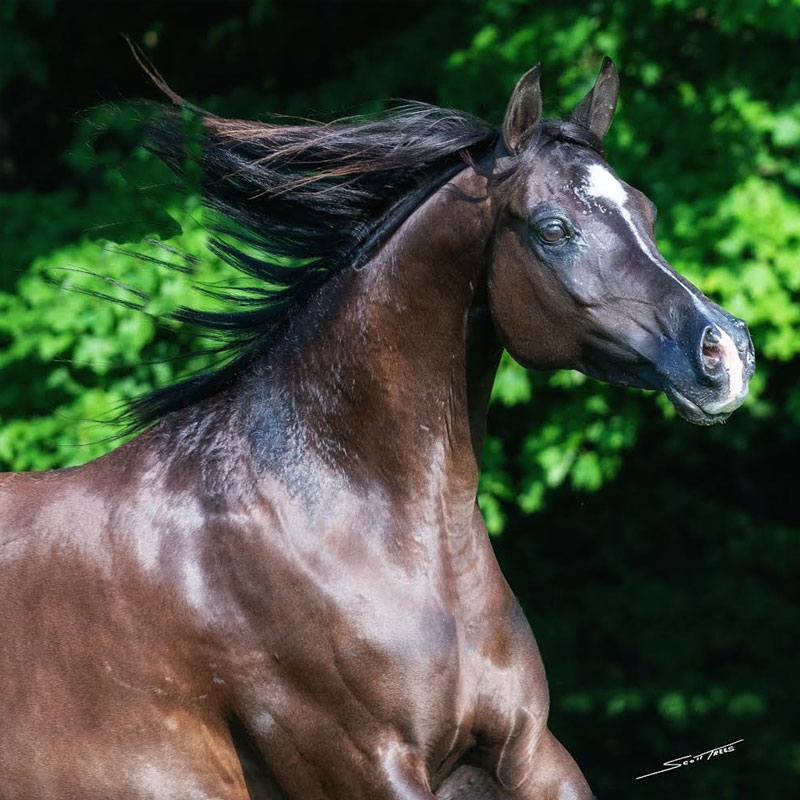
Amer Sorreya (The Legend x AA Baarissah).
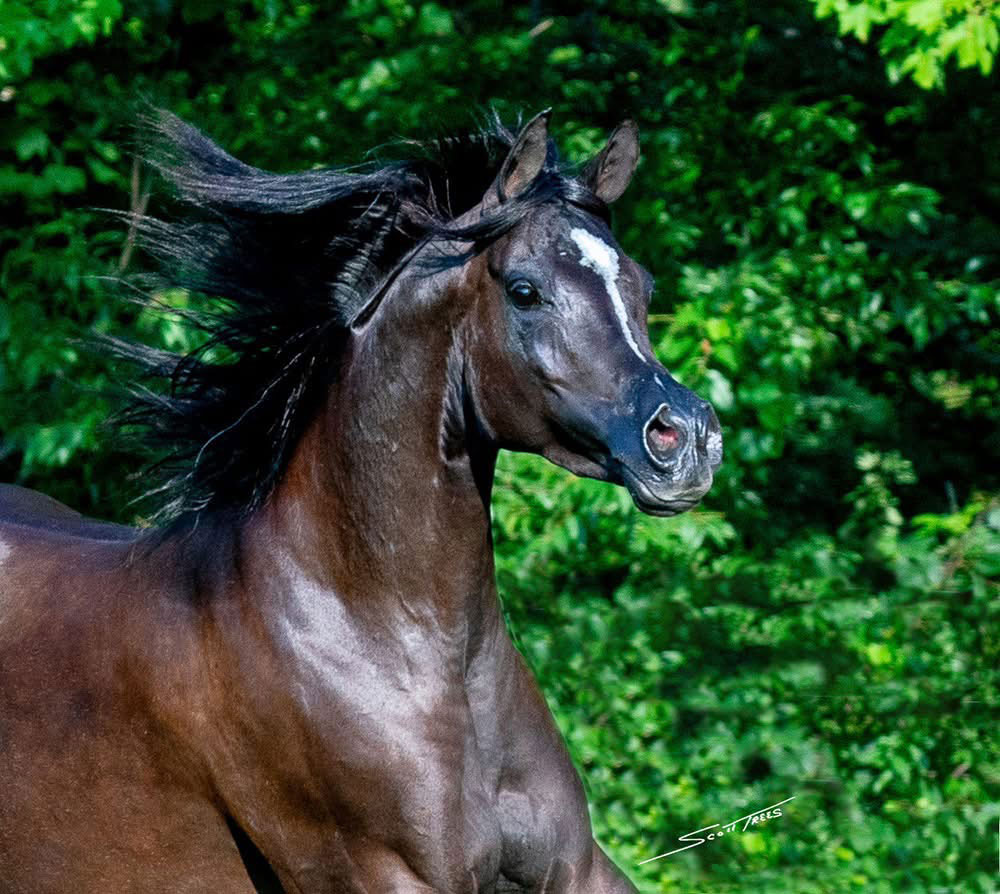
Sorreya’s daughter, Amer Sucar (Justynn x Amer Sorreya).
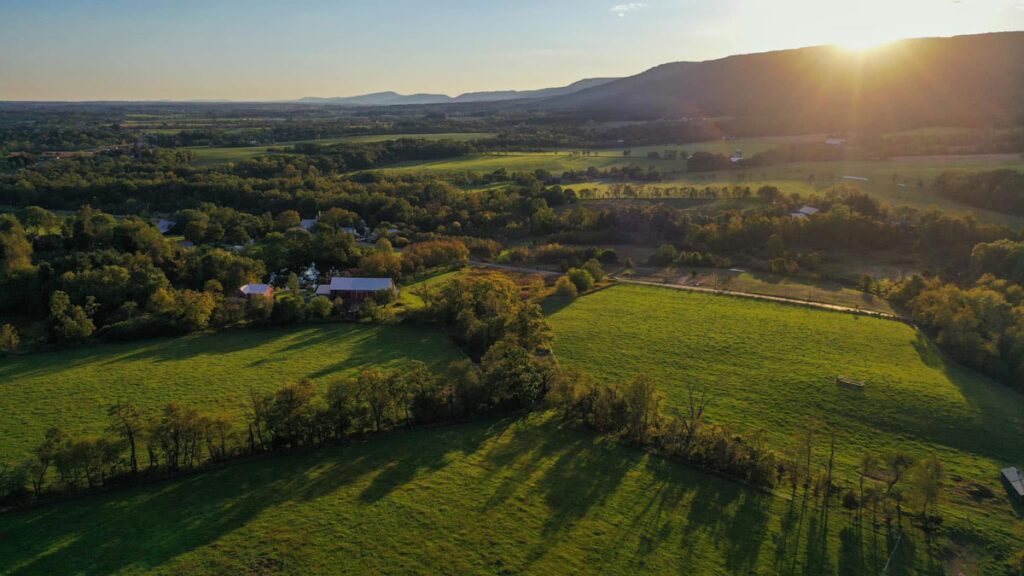
Doubling Gap Ranch outside of Newville, Pennsylvania.
In the Yorklyn Arabians barn fire, all the horses lost their lives except for one mare that caught Grant’s attention in 2014. He went to save the mare, Amer Sorreya, who had burns over 2/3 of her body. After many skin grafts and countless hours spent nursing her back to health, she foaled a beautiful Botswana daughter named Amer Hiba in June 2015. A Straight Egyptian mare by breeding and a kind, loving mare by nature, Amer Sorreya piqued the interest of the Bilbrey family in the Arabian breed. They decided to breed her again in 2017, with frozen semen to the SE stallion Justynn, who had also passed in the fire. The resulting foal was the stunning black show filly Amer Sucar, who put the Bilbreys firmly on that age-old path of the Arabian breed.
Enter long-time breeder, trainer, and Straight Egyptian expert Eileen Verdick, who guided Imperial Egyptian Stud to their glory years of the 80s and 90s. Eileen had the same concerns about the Arabian breed that JP had about the working Quarter Horses: that their “foundation” was being lost to modern fad breeding, and the horses were losing the qualities that had made them great. Eileen was already aware of the same situation with the Straight Egyptians and had quietly accessed frozen semen to some of the legendary sires from years ago. The stallions PVA Kariim (Imperial Imdal++ x BKA Rakiisah by The Egyptian Prince), *Imperial Madheen (Messaoud x Madinah by Ibn Galal), Ansata Halim Shah (*Ansata Ibn Halima++ x Ansata Rosetta by Ansata Shah Zaman), Ansata Sinan (Prince Fa Moniet x Ansata Nefara by Ansata Halim Shah) and Prince Fa Moniet (The Egyptian Prince x Fa Moniet by *Ibn Moniet El Nefous) were all available by frozen semen, but it was a fragile and costly process having to use the ICSI process. To make it simple, ICSI stands for Intracytoplasmic Sperm Injection, where a mare’s egg is flushed, one sperm cell is injected into it, and the egg is replanted (usually) into a recipient mare. A noble cause and a Godsend for modern Egyptian breeders to utilize, this process brings the hybrid-vigor of the earlier Egyptian horses forward to give breeders today options in their breeding programs. JP furthered his interest when he acquired two fillies and a colt by PVA Kariim and a colt and a filly by Ansata Halim Shah through Eileen in 2021 through 2023. JP and Grant have judiciously used the semen they’ve acquired to these legendary stallions and have a stunning *Imperial Madheen filly and two more *Imperial Madheen foals on the way for next year, creating an opportunity for future breeders looking to out-cross this invaluable blood into their programs.
A Note from JP Bilbrey
While the Arabian Horse’s history spans millennia, our relationship with them began in the 1990s in the deserts of Saudi Arabia and Egypt. From there, it has been a beautiful part of the Bilbrey Family experience.
When you are an expat family in a foreign country, you are brought closer together by a natural dependence on each other. And, many of your experiences are shared, creating and weaving together your own unique “fabric” of life. For us, that fabric includes a magical and prominent role shared with riding and living daily with the Arabian Horse.
When we moved to Cairo in 1995, we settled in Maadi, near where our kids would attend Cairo American College. Our Apartment was conveniently located close by, and my office was in the World Trade Center in the city. As experienced expats who had already lived outside the US and acculturated to the region, we quickly set to work exploring how we would spend our time outside of work.
One of my predecessors had been very involved with Horses in Egypt, and we quickly determined we, too, would indulge in this incredible opportunity to experience the desert, people, and, of course, the amazing Arabian horse at its origin. As a family, our previous involvement had been with Quarter Horses. As they say, when in Rome… With the help of a local businessman, we built a modest apartment and stable on the Giza plateau in a small village surrounded by very common local people. The people of Egypt are gracious, loving, and inviting. Oh yes, we could sit on our apartment stables’ veranda (roof) and see the Great Pyramids.
Teresa rode horses almost daily, and the family gathered on weekends for wondrous adventures together. We kept seven stallions and two mares in our very local stables, staffed by young men from upper rural Egypt. This is our foundation story with the Egyptian Arabian Horse.
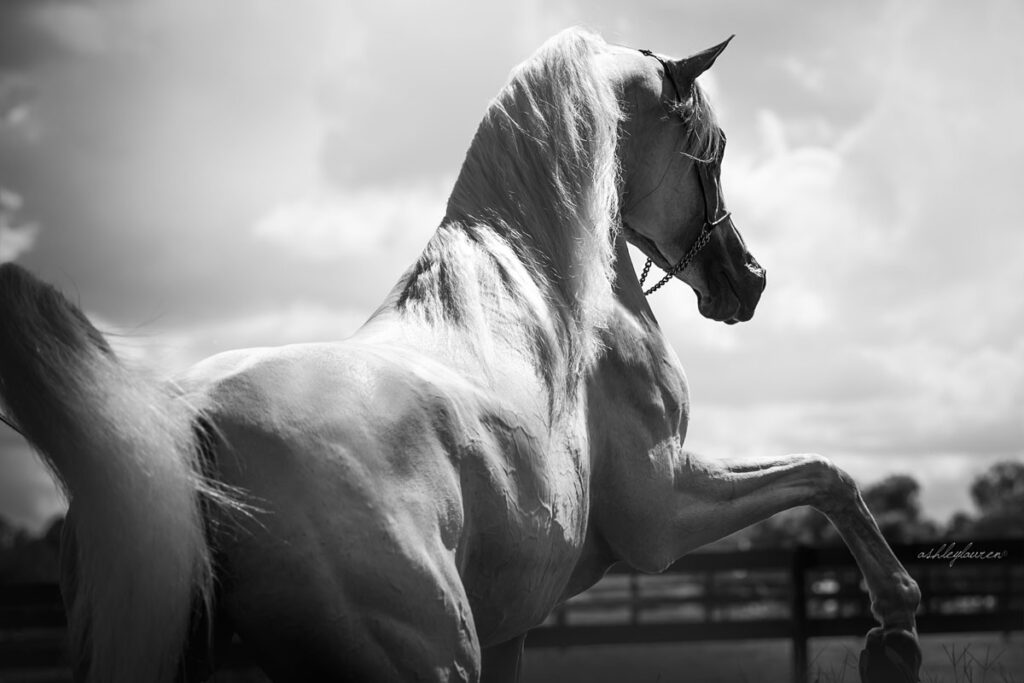
This issue’s cover stallion, Kareem Alfala (PVA Kariim x Ansata Nile Nefertiti by Ansata Sinan), was one of the original ICSI colts purchased by the Bilbrey’s in 2023. A special colt from birth, he is maturing into one of the most intriguing and unique stallions (Egyptian or otherwise) available today. His show career has been spectacular, with wins at the Scottsdale International SE classes and a US National Top Ten with the Bilbrey’s trainer and friend, Mike Wilson. This year, Kareem Alfala will breed three of Doubling Gap’s best mares: Paloma AP, Wasima Alfala, and the excellent show mare Amer Sucar for his first foals at the home ranch. As I type this, the great breeder, Allison Mehta, has TF Shaadonay (*Baja AA x TF Shaambalah by Botswana) waxing up in a foaling stall for the first Kareem Alfala foal to hit the ground. When I asked Allison why she chose Kareem, she said he was a quality stallion with great legs and feet, a smooth body, superb straight-tail carriage, and a great mover. I was glad I wasn’t the only one when she, too, thought Kareem Alfala resembled a modern-day *Morafic style stallion in looks and quality. High praise coming from a lady who has worked so hard to keep interest in Straight Egyptian breeding alive for the next generation.
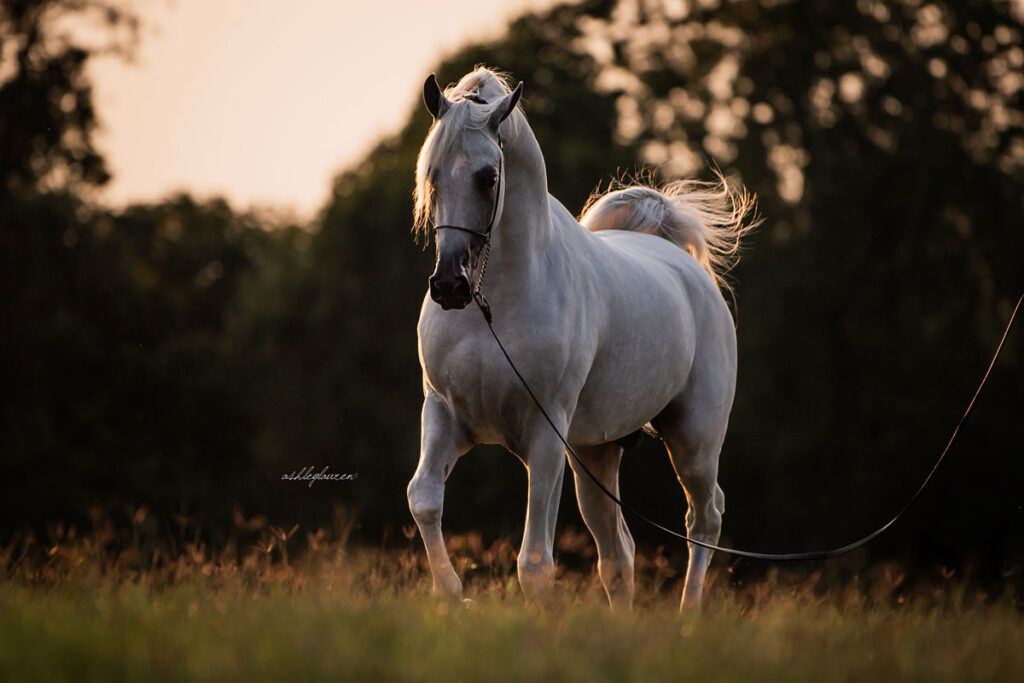
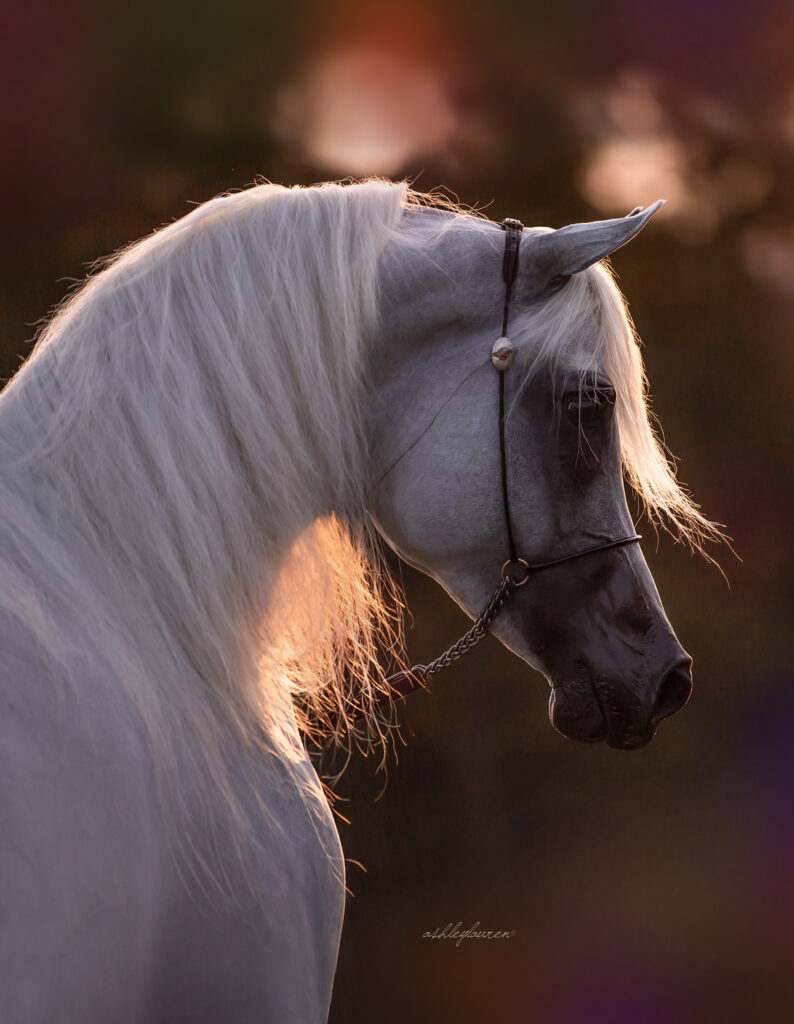
Kareem Alfala on AHW’s Spring Cover.
A breeding stallion is only as good as his pedigree, and Kareem Alfala checks all the boxes as a breeding stallion. His bloodlines combine the best of the old, classic breeding programs of Gleannloch, Ansata, Bentwood, Rancho San Ignacio, and Imperial Egyptian Stud. He is line-bred to the illustrious Nazeer sons *Ansata Ibn Halima++ (x Halima by Sheikh Al Arab) and *Morafic (x Mabrouka by Sid Abouhom) with 16 crosses to the two stallions, slightly heavier on the *Morafic crosses which is why Kareem Alfala resembles him so much. His mare line goes back to old Babson breeding through *Bint Bint Sabbah (Baiyad x Bint Sabah by Kazmeen), and it’s the Ansata branch of this mare line that is behind 1980 US National Champion Mare Fa-Halima and the “Nile” dynasty at Ansata, Imperial Egyptian Stud and Hadaya Arabians. Nazeer was the horse that changed breeding forever at the EAO, and he’s well represented in Kareem Alfala’s pedigree through his daughters *Ansata Bint Mabrouka, her full blood sister *Bint Mona, *Bint Moniet El Nefous, three-time US National Top Ten in Halter, Park and English Pleasure *Bint Maisa El Saghira++ and *Ansata Bint Bukra.
On his sire’s side, Kareem Alfala is by PVA Kariim (Imperial Imdal+ x BKA Rakiisah by The Egyptian Prince), the sire of Silver World Champion at the Salon du Cheval in Paris, Imperial Baarez, who was the only horse to defeat the great *Marwan Al Shaqab in their age group class at Paris. His grand-sire, The Egyptian Prince (*Morafic x *Bint Mona by Nazeer), is the result of a full-blood brother/sister mating and is one of the most important new Egyptian sires in our breed. Imperial Imdal+ (Ansata Imperial x Dalia++ by *Morafic) left prominent breeding stallions and mares in Israel at Ariely Arabians and the US. During his show career, Imperial Imdal+ was twice US National Top Ten Stallion, US Reserve National Champion Stallion in 1988, and World Champion Stallion at Paris in 1986, which isn’t a bad record for a horse owned by the Vallee family of relatively modest means. Flushing out Kareem Alfala’s pedigree a little further is his maternal grand-sire, Ansata Sinan (Prince Fa Moniet x Ansata Nefara by Ansata Halim Shah), a full brother to US National Top Ten Ansata Iemhotep and the sire of World Champion Stallion Eternity Ibn Navarrone-D, super-sire Khidar and grand-sire of World Champion Stallion Escape Ibn Navarrone-D as a bonus.
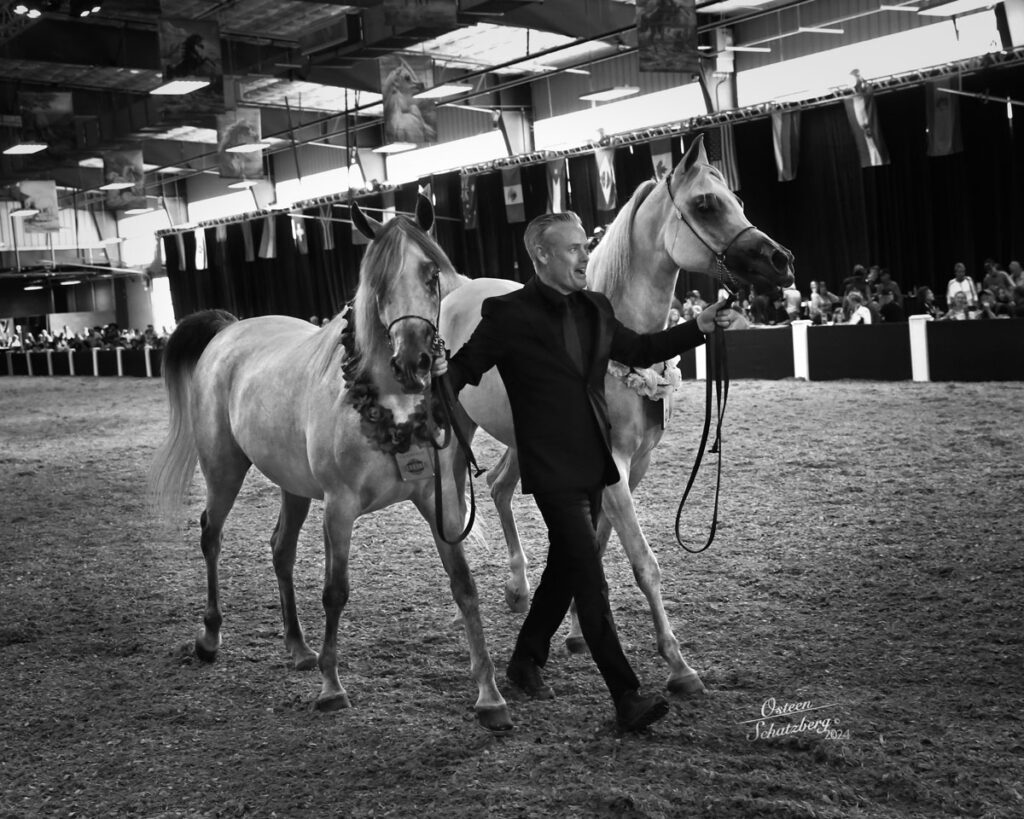
Sisters Watfa Al Fala and Thafra Al Fala going Champion and Reserve Champion at Scottsdale in the Straight Egyptian International Mare class.
Two of the young stars of the Doubling Gap program are the paternal sisters Watfa Al Fala (PVA Kariim x Ansata Valentina by Ansata Qasim) and Thafra Al Fala (PVA Kariim x Xandria HES by AMA Fa-Serr), who is line-bred to PVA Kariim being by him and out of a PVA Kariim granddaughter. Both of these 6-year-old mares have proven themselves in the show ring under the experienced hands of Mike Wilson and are now in the broodmare barn. In 2024, Thafra Al Fala was named Scottsdale Champion SE International Mare while her sister Watfa Al Fala was named Reserve Champion in the same class. Mare lines are essential to the Bilbreys, as they should be to all breeders. Thafra Al Fala brings in the Bint Samiha branch of the Venus mare line, which produced the noted stallions Nazeer and his son, Hadban Enzahi of Weil-Marbach State Stud and the important EAO breeding stallion Shaarawi (Morafic x Bint Kamla by El Sareei). She has a stunning 2023 filly by the legendary *Imperial Madheen named DGR Najiyah Madheen, 2026 will bring two more *Imperial Madheen foals out of Thafra Al Fala.
Reserve Champion Scottsdale SE International Champion Mare Watfa Al Fala was also Region 12 Classic Senior Reserve Champion Mare. Her distaff side of the pedigree goes back through 7 generations of Ansata breeding to Judi Forbes dynastic *Ansata Bint Bukra (Nazeer x Bukra by Shahloul), through her granddaughter, Ansata Delilah (by Ansata Shah Zaman). This is the mare line that produced the breeding and show stallions Ansata Halim Shah, the brothers Ansata Iemhotep and Ansata Sinan, and Imperial Egyptian Studs foundation sire, Ansata Imperial (Ansata Ibn Sudan x Ansata Delilah), and countless incredible producing mares. Watfa Al Fala is expecting two foals by the young sire Naseem Al Rashediah, who is by Aachen and Paris/World Champion Stallion, *Al Adeed Al Shaqab (by Ansata Halim Shah) and out of a mare of generations of Ansata and Dr. Nagel breeding.
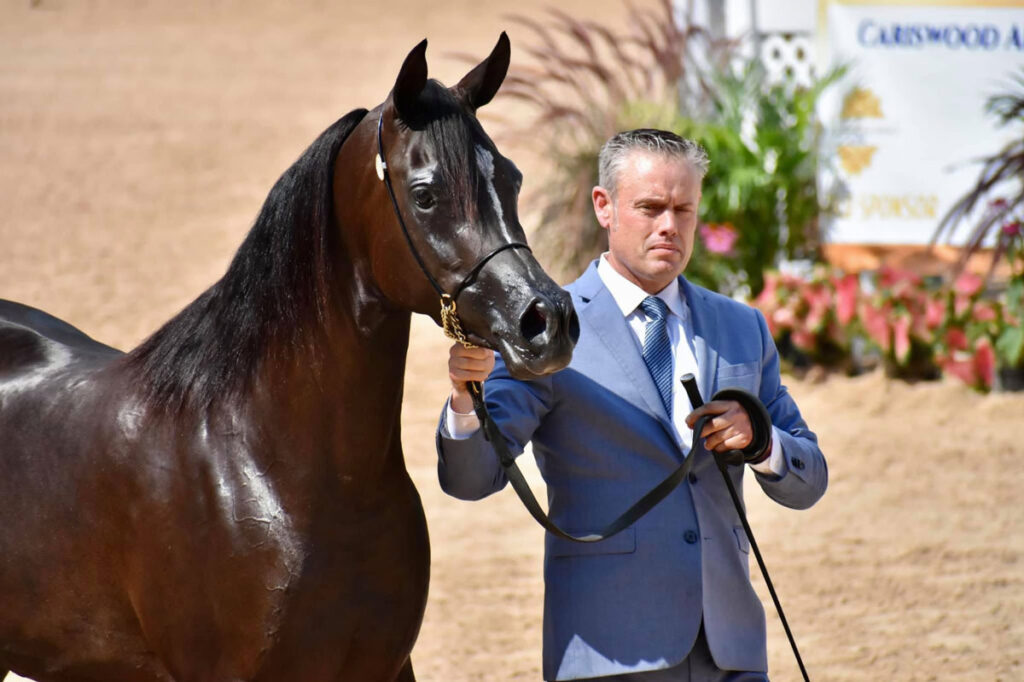
Amer Sucar and Mike Wilson.
Two of the young stars of the Doubling Gap program are the paternal sisters Watfa Al Fala (PVA Kariim x Ansata Valentina by Ansata Qasim) and Thafra Al Fala (PVA Kariim x Xandria HES by AMA Fa-Serr), who is line-bred to PVA Kariim being by him and out of a PVA Kariim granddaughter. Both of these 6-year-old mares have proven themselves in the show ring under the experienced hands of Mike Wilson and are now in the broodmare barn. In 2024, Thafra Al Fala was named Scottsdale Champion SE International Mar while her sister Watfa Al Fala was named Reserve Champion in the same class. Mare lines are essential to the Bilbreys, as they should be to all breeders. Thafra Al Fala brings in the Bint Samiha branch of the Venus mare line, which produced the noted stallions Nazeer and his son, Hadban Enzahi of Weil-Marbach State Stud and the important EAO breeding stallion Shaarawi (Morafic x Bint Kamla by El Sareei). She has a stunning 2023 filly by the legendary *Imperial Madheen named DGR Najiyah Madheen, 2026 will bring two more *Imperial Madheen foals out of Thafra Al Fala.
Reserve Champion Scottsdale SE International Champion Mare Watfa Al Fala was also Region 12 Classic Senior Reserve Champion Mare. Her distaff side of the pedigree goes back through 7 generations of Ansata breeding to Judi Forbes dynastic *Ansata Bint Bukra (Nazeer x Bukra by Shahloul), through her granddaughter, Ansata Delilah (by Ansata Shah Zaman). This is the mare line that produced the breeding and show stallions Ansata Halim Shah, the brothers Ansata Iemhotep and Ansata Sinan, and Imperial Egyptian Studs foundation sire, Ansata Imperial (Ansata Ibn Sudan x Ansata Delilah), and countless incredible producing mares. Watfa Al Fala is expecting two foals by the young sire Naseem Al Rashediah, who is by Aachen and Paris/World Champion Stallion, *Al Adeed Al Shaqab (by Ansata Halim Shah) and out of a mare of generations of Ansata and Dr. Nagel breeding.
Other mares at Doubling Gap include the striking black Amer Sucar (Justynn x Amer Sorreya by The Legend), an important show mare with Championships at the Scottsdale International Show, the East Coast Classic, the Egyptian Event, and Region 12. Amer Sucar is line-bred to Ruminaja Ali (Shaikh Al Badi x Bint Magidaa by *Khofo) through The Minstril and brings in additional crosses to PVA Kariim through Imperial Baarez with an Imperial mare line going back to Imperial Misteena (*Imperial Madheen x Ansata Nile Mist by Ansata Ibn Sudan). Amer Sucar’s 2-year-old daughter, DGR Khalifa Bint Naseet (by Naseem Al Rashediah), and her maternal sister, Amer Hiba (Botswana x Amer Sorreya), a striking chestnut mare, share the Ansata Nile Mist mare line along with their dam and Teresa Bilbrey’s heart horse, Amer Sorreya (The Legend x AA Baarissah by Imperial Bareez). Rounding out the broodmare band is the lovely, grey Regional performance winner Paloma AP, sired by the World Champion *Al Adeed Al Shaqab son LF Al Saher and out of a *Mishaal HP daughter who goes back in tail-female to the same mare line that produced US National Champion Mare, *Serenity Sonbolah.
The plans for Kareem Alfala at Doubling Gap are what every true horseman and breeder hopes for post-halter, a career under saddle. Mike Wilson feels he’s one of the most naturally athletic and good-minded SE stallions he’s ever had in his barn, and that’s saying a lot, with Kareem having unlimited potential as a Hunter Pleasure horse. The Bilbrey’s plans include nominating him as a Breeder’s Sweepstakes Sire, which will give anyone breeding to Kareem Alfala the advantage of showing halter as a youngster and then bringing them along to a performance career. If you have any questions about this exciting young stallion, feel free to contact Grant Bilbrey or Mike Wilson; they’ll be happy to help you with any questions. And, it goes without saying, Kareem Alfala is available to SE mares and mares of all bloodlines as Egyptian-sired stallions (think *Gazal Al Shaqab, *El Shaklan, and Ali Jamaal, just to name a few) are some of the most prolific pedigree elements in the world.
As a quick side-note, I’ve done interviews over the years with everyone from Sheila Varian to Gene LaCroix to Bazy Tankersley and Bill Munson. They all spoke of their history, love, and devotion to our breed. My time spent working with Grant Bilbrey ranks right up there with these legendary breeders, as his passion, enthusiasm, and love for our breed match theirs. Thanks for your family’s dedication to helping take a breed to the next level, both as Arabian horses and straight Egyptians.
Stars Over Siwa: A Seventh-Grade Journey into the Heart of the Arabian Horse
By Grant Bilbrey
In seventh grade, I had the rare and unforgettable opportunity to travel from Cairo to the Siwa Oasis—on horseback and camelback—with thirty classmates and a few brave teachers from Cairo American College. Led by Bedouin guides across the vast, wind-swept desert, we lived for several days in the rhythm of the dunes, far from the modern world. It was a journey that shaped my understanding of the Arabian horse, not just as a breed but as a living piece of cultural heritage.
We rode under skies so wide and clear that the stars felt close enough to touch. Each night, after a long day of riding, we would gather around the fire where our Bedouin hosts made fresh naan over open flames. Goats walked alongside us during the day and slaughtered for dinner in the evening, shared among the group with a sense of reverence for the land and its traditions.
What struck me most was seeing the Arabian horse in its natural environment—nimble, proud, and tireless in the shifting sands. These horses weren’t adorned or presented for show. They were being used exactly as they were intended: navigating the desert with elegance, carrying us with ease, and forming quiet, trusting bonds with the Bedouins who rode beside us. Even at that young age, I could sense that I was witnessing something sacred—this wasn’t just history, it was legacy in motion.
That trip taught me more about Arabian horses than any classroom could. It gave me a deeper connection to the breed, one rooted in its origin and purpose. When I look at the horses I raise today, I still see echoes of that seventh-grade journey—the desert wind, the flicker of firelight, and, above all, the stars. It was six unforgettable days that became a core memory of my time spent in Egypt.




